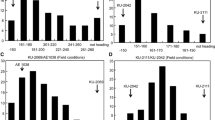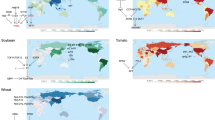Summary
Induction of flowering by photoperiod was studied in the parental, F1, F2, and reciprocal backcross generations of crosses between three photoperiod-responsive Aeschynomene americana L. lines. Generation means appeared additive. Analysis with Mather and Jinks' scaling tests showed little or no epistasis and indicated that an additive-dominance model was adequate. Partitioning components of variation revealed that nearly all variation was additive genetic with dominance and environmental variation negligible. An additive genetic model with two loci, each with two alleles and all alleles having equal net effect, was tested using Power's partitioning method. Results demonstrated that the model fit the data and that there is a major additive genetic system controlling flowering in these crosses, with minor genetic and environmental influences present. Selection for flowering at a desired day length should be feasible.
Similar content being viewed by others
References
Falconer DS (1981) Introduction to quantitative genetics, 2nd edn. Longman, New York
Gate Research Co (1977) Sunrise and sunset tables for key cities and weather stations of the U.S. Compiled by Gate Research Co, Detroit
Hardy SR, Quesenberry KH (1984) Artificial hybridization of Aeschynomene americana L. (a tropical forage legume). Proc Soil Crop Soc Fl 43:163–166
Ison RL (1983) Climatic control of Stylosanthes guianensis flowering. J Aust Inst Agric Sci 49:162–163
Leonard WH, Mann HO, Power L (1957) Partitioning method of genetic analysis applied to plant-height inheritance in barley. Colo Agric Exp Stn Tech Bull 60:2–24
Mather K (1949) Biometrical genetics. Dover, New York
Mather K, Jinks JL (1971) Biometrical genetics. Cornell University Press, Ithaca
Murfret IC (1973) Flowering in Pisum. Hr, a gene for high response to photoperiod. Heredity 31:157–164
Murfret IC (1977) Environmental interaction and the genetics of flowering. Annu Rev Plant Physiol 28:253–278
Powers L (1955) Components of variance method and partitioning method of genetic analysis applied to weight per fruit of tomato hybrid and parental populations. USDA Tech Bull No 1131
Powers L (1963) The partitioning method of genetic analysis and some aspects of its application to plant breeding. In: Hanson WD, Robinson HF (eds) Statistical genetics and plant breeding. NAS, NRC 982:280–318
Powers L, Locke LF (1950) Partitioning method of genetic analysis applied to quantitative characters of tomato crosses. USDA Tech Bull No 998
Sage GMC, de Isturiz MJ (1974) The inheritance of anther extrusion in two spring wheat varieties. Theor Appl Genet 45:126–133
Swindell RE, Poehlman JM (1978) Inheritance of photoperiod response in mungbean (Vigna radiata [L.] Wilczek). Euphytica 27:325–333
Author information
Authors and Affiliations
Additional information
Accepted by A.R. Hallauer
Florida Agricultural Experiment Station, Journal Series No. 9251
Rights and permissions
About this article
Cite this article
Deren, C.W., Quesenberry, K.H. Inheritance of photoperiod-induced flowering in three photoperiodic lines of Aeschynomene americana L.. Theoret. Appl. Genetics 78, 825–830 (1989). https://doi.org/10.1007/BF00266665
Received:
Accepted:
Issue Date:
DOI: https://doi.org/10.1007/BF00266665




